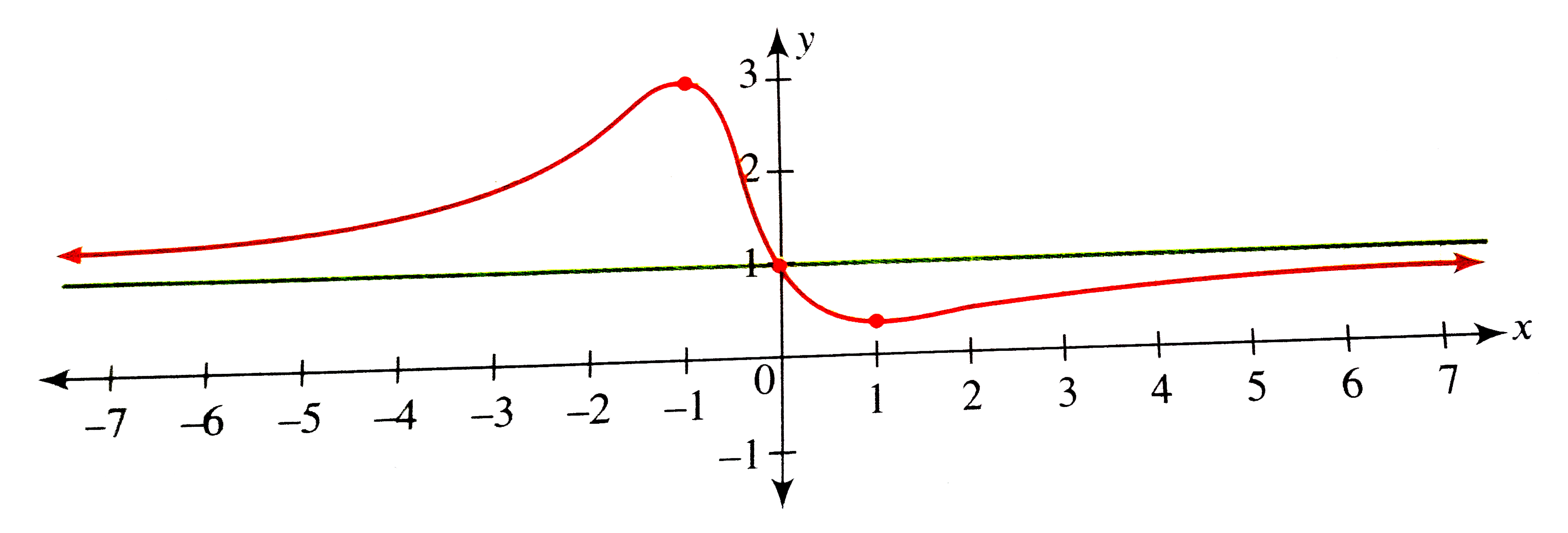Draw the graph of Solution in Tamil
The domain of the function is R as has no real roots.
1. y-intercept
So the graph cuts the y-axis at (0,1).
2. x-intercept (zeros)
Put or .
This equation has no real roots.
Hence the graph does not intersect the x-axis.
3. Asymptotes
Vertical asymptotes
Since had no real roots, the graph has no vertical asymptote.
Horizontal asymptotes
Since the degree of the numerator and that of the denominator are same, the horizontal asymptote is
or or
Clearly, the graph has no ablique asymptote.
4. Extremum
Sign scheme of is as follows.

From the sign scheme, x = 1 is the point of minima and x = -1 is the point of maxima.
Also and .
From the above discussion, we have the following reference points and lines.

When and in increases from '1' to '3'.
At attains the maximum value '3'.
In decreases from '3' to '1/3' intersecting the y-axis at (0, 1) and attains minima at x = 1.
In increases from '1/3' to '1' and finally approaches to asymptote y = 1 when .
Thus , the graph of is as shown in the following figure.

Topper's Solved these Questions
- GRAPHS OF POLYNOMIAL AND RATIONAL FUNCTIONSBook:CENGAGEChapter:GRAPHS OF POLYNOMIAL AND RATIONAL FUNCTIONSExercise:Exercise
Explore 13 Videos
- GRAPHS OF POLYNOMIAL AND RATIONAL FUNCTIONSBook:CENGAGEChapter:GRAPHS OF POLYNOMIAL AND RATIONAL FUNCTIONSExercise:Exercises
Explore 4 Videos
- GRAPHICAL TRANSFORMATIONSBook:CENGAGEChapter:GRAPHICAL TRANSFORMATIONSExercise:Exercise
Explore 14 Videos
- GRAPHS OF ELEMENTARY FUNCTIONS Book:CENGAGEChapter:GRAPHS OF ELEMENTARY FUNCTIONS Exercise:Exercise
Explore 34 Videos
Similar Questions
Draw the graph of y=(x−1)(x2−x+1).
View SolutionSketch the graph of an example of a rational function f that satisfies all the given conditions.
(i) f(0)=0,f(1),limx→∞f(x)=0,f is odd
(ii) limx→0+f(x)=∞,limx→0−f(x)=−∞,limx→∞f(x)=1,limx→−∞f(x)=1
(iii) limx→−2f(x)=∞,limx→−∞f(x)=3,limx→∞f(x)=3,f(0)=0
View SolutionDraw the graph of y=tan−1x−cot−1x.
View SolutionDraw the graph of y=1(1/x).
View SolutionDraw the graph of f(x)=∣∣∣x2−2x2−1∣∣∣ .
View SolutionDraw the graph of f(x)=x2−5x+6x2−x
View SolutionDraw the graph of f(x)=5x2(x−1)3.
View Solutiony=f(x)=x2−6x+9 का आलेख खींचे |
View SolutionDraw the graph of y=x2−5x+6 and hence solve x2−5x−14=0.
View SolutionDraw the graph for the polynomial p(x)=x2−5x+6 and find the zeroes from the graph.
View Solution(a) Draw the graph of y=x2 and hence solve x2−4x−5=0.
(b) Draw the graph of y=x2−5x−6 and hence solve x2−5x−14=0
View SolutionDraw the graph of function f'(x) if f(x)=2x2−5x+3
View SolutionDraw the graph of f(x)=∣∣∣x2−2x2−1∣∣∣ .
View SolutionDraw the graph of f(x)=x2−5x+6x2−x
View SolutionDraw the graph of f(x)=∣∣∣x2−2x2−1∣∣∣ .
View SolutionDraw the graph of f(x)=5x2(x−1)3.
View Solution